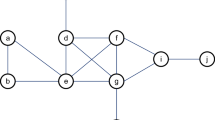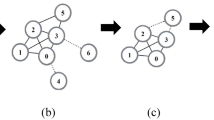Abstract
The identification of vital spreaders in complex networks has been one of the most interesting topics in network science. Several methods were proposed to deal with this challenge, but there still exist deficiencies in previous methods, such as excessive time complexity, inadequate accuracy of recognition results after dividing the topological structure, and the ignorance of neighbors’ attribute information in the links’ significance model. To address these issues and promote identifying ability more effectively, the proposed extended centrality upon hybrid information, named EISMC, introduces the interpretative structure model (ISM) and improves hierarchical weight results after the division in hierarchies. Based on the hierarchical structure of Improved Kshell decomposition (IKs), the weight value of each layer is updated, and meanwhile the local centrality under link significance (LinkC) is created to supplement local features in this method. In this paper, six real-world networks and nine comparison methods are applied to conduct a series of simulations and tests. Results demonstrate that the proposed method outperforms state-of-the-art algorithms in the identifying effects for good spreading influence.








Similar content being viewed by others
References
Strogatz SH (2001) Exploring complex networks. Nature 410(6825):268–276
Boccaletti S, Latora V, Moreno Y, Chavez M, Hwang D-U (2006) Complex networks: structure and dynamics. Phys Rep 424(4–5):175–308
Albert R, Barabási A-L (2002) Statistical mechanics of complex networks. Rev Mod Phys 74(1):47
Song C, Havlin S, Makse HA (2005) Self-similarity of complex networks. Nature 433(7024):392–395
Ruths J, Ruths D (2014) Control profiles of complex networks. Science 343(6177):1373–1376
Pagani GA, Aiello M (2013) The power grid as a complex network: a survey. Phys A Stat Mech Appl 392(11):2688–2700
Chen C, Zhou X, Li Z, He Z, Li Z, Lin X (2018) Novel complex network model and its application in identifying critical components of power grid. Phys A Stat Mech Appl 512:316–329
Curado M, Tortosa L, Vicent JF, Yeghikyan G (2020) Analysis and comparison of centrality measures applied to urban networks with data. J Comput Sci 43:101127
Lin J, Ban Y (2013) Complex network topology of transportation systems. Transp Rev 33(6):658–685
De Bona AA, Oliveira Rosa M, Fonseca KVO, Lüders R (2021) A reduced model for complex network analysis of public transportation systems. Phys A Stat Mech Appl 567:125715
Xu R, Mi C, Mierzwiak R, Meng R (2020) Complex network construction of internet finance risk. Phys A Stat Mech Appl 540:122930
Fadhil SA (2021) Internet of things security threats and key technologies. J Discret Math Sci Cryptogr 24(7):1951–1957
Zengler K, Zaramela LS (2018) The social network of microorganisms-how auxotrophies shape complex communities. Nat Rev Microbiol 16(6):383–390
Centola D (2010) The spread of behavior in an online social network experiment. Science 329(5996):1194–1197
Zhao Z, Chen D, Wang L, Han C (2018) Credit risk diffusion in supply chain finance: a complex networks perspective. Sustainability 10(12):4608
Fath BD, Scharler UM, Ulanowicz RE, Hannon B (2007) Ecological network analysis: network construction. Ecol Model 208(1):49–55
Hughes J, Allen RC, Baguelin M, Hampson K, Baillie GJ, Elton D, Newton JR, Kellam P, Wood JL, Holmes EC et al (2012) Transmission of equine influenza virus during an outbreak is characterized by frequent mixed infections and loose transmission bottlenecks. PLoS Pathogens 8(12):1003081
Wertheim JO, Leigh Brown AJ, Hepler NL, Mehta SR, Richman DD, Smith DM, Kosakovsky Pond SL (2014) The global transmission network of HIV-1. J Infect Dis 209(2):304–313
Zhong S, Zhang H, Deng Y (2022) Identification of influential nodes in complex networks: a local degree dimension approach. Inf Sci 610:994–1009
Barabási A-L (2013) Network science. Philos Trans Royal Soc A Math Phys Eng Sci 371(1987):20120375
Khosravi E, Yazdanifar F, Salimi N, Beni HA (2023) Identify initial nodes for spreader in a new diffusion model based on topology (dbt) in social networks. In: 2023 9th International Conference on Web Research (ICWR), pp. 52–57. IEEE
Tong T, Dong Q, Sun J, Jiang Y (2023) Vital spreaders identification synthesizing cross entropy and information entropy with kshell method. Expert Syst Appl 224:119928
Liu X, Ye S, Fiumara G, De Meo P (2022) Influential spreaders identification in complex networks with topsis and k-shell decomposition. IEEE Trans Comput Soc Syst 10(1):347–361
Bonacich P (1972) Factoring and weighting approaches to status scores and clique identification. J Math Sociol 2(1):113–120
Li Z, Ren T, Ma X, Liu S, Zhang Y, Zhou T (2019) Identifying influential spreaders by gravity model. Sci Rep 9(1):1–7
Liu Y, Tang M, Zhou T, Do Y (2016) Identify influential spreaders in complex networks, the role of neighborhood. Phys A Stat Mech Appl 452:289–298
Yang X-H, Xiong Z, Ma F, Chen X, Ruan Z, Jiang P, Xu X (2021) Identifying influential spreaders in complex networks based on network embedding and node local centrality. Phys A Stat Mech Appl 573:125971
Xu G-Q, Meng L, Tu D-Q, Yang P-L (2021) Lch: A local clustering h-index centrality measure for identifying and ranking influential nodes in complex networks. Chin Phys B 30(8):088901
Wen T, Pelusi D, Deng Y (2020) Vital spreaders identification in complex networks with multi-local dimension. Knowl Based Syst 195:105717
Kitsak M, Gallos LK, Havlin S, Liljeros F, Muchnik L, Stanley HE, Makse HA (2010) Identification of influential spreaders in complex networks. Nat Phys 6(11):888–893
Liu Z, Jiang C, Wang J, Yu H (2015) The node importance in actual complex networks based on a multi-attribute ranking method. Knowl Based Syst 84:56–66
Ma L-L, Ma C, Zhang H-F, Wang B-H (2016) Identifying influential spreaders in complex networks based on gravity formula. Phys A Stat Mech Appl 451:205–212
Liu J-G, Ren Z-M, Guo Q (2013) Ranking the spreading influence in complex networks. Phys A Stat Mech Appl 392(18):4154–4159
Liu Y, Tang M, Zhou T, Do Y (2015) Core-like groups result in invalidation of identifying super-spreader by k-shell decomposition. Sci Rep 5(1):1–8
Sun PG, Miao Q, Staab S (2021) Community-based k-shell decomposition for identifying influential spreaders. Pattern Recogn 120:108130
Bao Z-K, Liu J-G, Zhang H-F (2017) Identifying multiple influential spreaders by a heuristic clustering algorithm. Phys Lett A 381(11):976–983
Li S, Xiao F (2021) The identification of crucial spreaders in complex networks by effective gravity model. Inf Sci 578:725–749
Namtirtha A, Dutta A, Dutta B, Sundararajan A, Simmhan Y (2021) Best influential spreaders identification using network global structural properties. Sci Rep 11(1):1–15
Wang M, Li W, Guo Y, Peng X, Li Y (2020) Identifying influential spreaders in complex networks based on improved k-shell method. Phys A Stat Mech Appl 554:124229
Wan Y-P, Wang J, Zhang D-G, Dong H-Y, Ren Q-H (2018) Ranking the spreading capability of nodes in complex networks based on link significance. Phys A Stat Mech Appl 503:929–937
Sun S, Ren T, Xu Y (2023) Edge-weights-based method to identify influential spreaders in complex networks. Trans Inst Meas Control, 01423312231182468
Freeman LC (1978) Centrality in social networks conceptual clarification. Soc Netw 1(3):215–239
Bonacich P, Lloyd P (2001) Eigenvector-like measures of centrality for asymmetric relations. Soc Netw 23(3):191–201
Bae J, Kim S (2014) Identifying and ranking influential spreaders in complex networks by neighborhood coreness. Phys A Stat Mech Appl 395:549–559
Zeng A, Zhang C-J (2013) Ranking spreaders by decomposing complex networks. Phys Lett A 377(14):1031–1035
Chen D, Lü L, Shang M-S, Zhang Y-C, Zhou T (2012) Identifying influential nodes in complex networks. Phys A Stat Mech Appl 391(4):1777–1787
Sheikhahmadi A, Nematbakhsh MA (2017) Identification of multi-spreader users in social networks for viral marketing. J Inf Sci 43(3):412–423
Mandal A, Deshmukh S (1994) Vendor selection using interpretive structural modelling (ism). Int J Oper Prod Manag
Haraldsdottir S, Gupta S, Anderson RM (1992) Preliminary studies of sexual networks in a male homosexual community in Iceland. J Acq Immune Defic Syndr 5(4):374–381
Gleiser PM, Danon L (2003) Community structure in jazz. Adv Complex Syst 6(04):565–573
Guimera R, Danon L, Diaz-Guilera A, Giralt F, Arenas A (2003) Self-similar community structure in a network of human interactions. Phys Rev E 68(6):065103
Rozemberczki B, Allen C, Sarkar R (2021) Multi-scale attributed node embedding. J Complex Netw 9(2):014
Castellano C, Pastor-Satorras R (2010) Thresholds for epidemic spreading in networks. Phys Rev Lett 105(21):218701
Rezaei AA, Jalili M, Khayyam H (2021) Influential node ranking in complex networks using a randomized dynamics sensitive approach. arXiv e-prints
Allen LJ (1994) Some discrete-time si, sir, and sis epidemic models. Math Biosci 124(1):83–105
Zar JH (2005) Spearman rank correlation. Encycl Biostat. 7
Arndt S, Turvey C, Andreasen NC (1999) Correlating and predicting psychiatric symptom ratings: Spearmans r versus kendalls tau correlation. J Psych Res 33(2):97–104
Funding
This work was supported by National Natural Science Foundation of China (Grant number: 52177090); Postgraduate Research & Practice Innovation Program of Jiangsu Province of China (Grant number: KYCX23_0476).
Author information
Authors and Affiliations
Corresponding author
Ethics declarations
Conflict of interest
The authors declare the following financial interests/personal relationships which may be considered as potential competing interests: TianChi Tong reports financial support was provided by National Natural Science Foundation of China and Postgraduate Research & Practice Innovation Program of Jiangsu Province of China.
Additional information
Publisher's Note
Springer Nature remains neutral with regard to jurisdictional claims in published maps and institutional affiliations.
Appendix
Appendix
Table 7 shows results of Kendall’s coefficient generated by each method and SIS in different networks in Sect. 4.4. Figure 8 represents running time costs of Cnc+, Kshell, MCDE, MDD, SCL and EISMC in six networks in Sect. 4.6.
Rights and permissions
Springer Nature or its licensor (e.g. a society or other partner) holds exclusive rights to this article under a publishing agreement with the author(s) or other rightsholder(s); author self-archiving of the accepted manuscript version of this article is solely governed by the terms of such publishing agreement and applicable law.
About this article
Cite this article
Tong, T., Dong, Q., Yuan, W. et al. Identifying vital spreaders in complex networks based on the interpretative structure model and improved Kshell. Computing (2024). https://doi.org/10.1007/s00607-024-01268-z
Received:
Accepted:
Published:
DOI: https://doi.org/10.1007/s00607-024-01268-z





